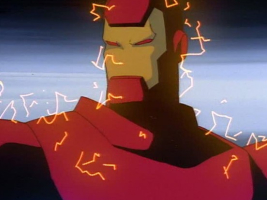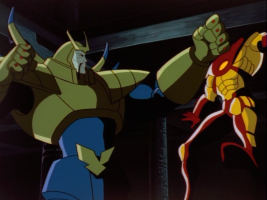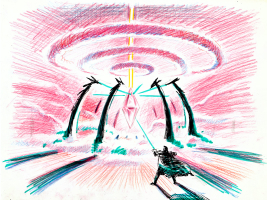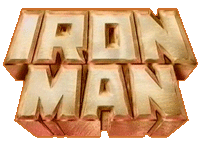 |
|
· Character Bios · Episode Guide · Episode Reviews · Interviews · Archives · Comic Gallery · Video Clips · Title Sequence · Releases · Downloads · Message Board · MAA Home Page
 |
|
|
Marvel Animation Age recently had the opportunity to interview Yi-Chih Chen, producer for the second season of Iron Man, the fan-favorite 1990s animated series. In the following interview, Chen provides his candid thoughts on making the second season of the Armored Avengers syndicated series!
Marvel Animation Age: How did you come to work on Iron Man and what did your duties include?
 Yi-Chih Chen: I was initially called by New World Animation to do freelance storyboard work for their new season of Iron Man in the spring of �95. The show�s Supervising Producer, Tom Tataranowicz was an old colleague of mine from Filmation days. While I was at the studio picking up work, Tom �nonchalantly� told me that they still hadn�t got a producer for the show and asked me (again nonchalantly) if I by any chance were interested. I was a bit surprised by the fact that the production had been three months into the year without a dedicated person in charge. A syndicate show usually had its crew assembled at the very beginning of the year, so that it could make the first air date in September. And a producer should be on board even before that (as in the case of Larry Houston for Fantastic Four, the other production lineup at New World at the time). This could mean two things: the cheapness of the production budget and the orphan status of the show. As it turned out Iron Man was indeed a �second thought� for Marvel tagged behind Fantastic Four as a bonus pack for selling toys.
Yi-Chih Chen: I was initially called by New World Animation to do freelance storyboard work for their new season of Iron Man in the spring of �95. The show�s Supervising Producer, Tom Tataranowicz was an old colleague of mine from Filmation days. While I was at the studio picking up work, Tom �nonchalantly� told me that they still hadn�t got a producer for the show and asked me (again nonchalantly) if I by any chance were interested. I was a bit surprised by the fact that the production had been three months into the year without a dedicated person in charge. A syndicate show usually had its crew assembled at the very beginning of the year, so that it could make the first air date in September. And a producer should be on board even before that (as in the case of Larry Houston for Fantastic Four, the other production lineup at New World at the time). This could mean two things: the cheapness of the production budget and the orphan status of the show. As it turned out Iron Man was indeed a �second thought� for Marvel tagged behind Fantastic Four as a bonus pack for selling toys.
But I didn�t care. By then I had done every conceivable job in animation (model designer, animator, story artist, director and overseas supervisor), I was eager to try something new. Tom certainly knew that well. Two weeks later, I got hired as the producer for the second season of Iron Man. That was already in April of �95.
For a syndicate show, a �producer� literally meant someone rolled up the sleeves doing anything and everything to deliver 13 finished (and hopefully miraculous) episodes on time and on budget. The last two were the most relevant for the job. In the case of Iron Man, it meant 12 hour workdays nonstop (no weekends either) for the whole 9 months. Considering the mountainous �duties� I was entrusted, my hands were extremely tied as a producer. I had little say on staffing, no say in scheduling, and don�t even think about budget! But I was younger and feeling (perhaps stupidly) invincible. I was determined to make a difference.
MAA: Iron Man was drastically different between its two seasons. What was your initial reaction to overtaking Iron Man?
YC: I have to confess my knowledge of Iron Man before the show was rather limited. In fact I started the show as a clean slate almost totally �uninitiated� of Marvel�s superhero universe. But unfamiliarity also meant no preconceived notion, judgment or restriction on the subject, which, I believe, enabled me to go about Iron Man in a much freer fashion than a �connoisseur�. I think my �ignorance� must have contributed somewhat to the �differentness� of the second season. With that said, I was thankful to have a knowledgeable Marvel fan on board, Keith Matz, my model designer.
My first impression of Iron Man was the character (not surprisingly) seemed clunky and awkward; I mean incasing oneself in an iron rocket was not exactly technologically elegant or physically superheroish. But the imagery of Iron Man�s mask immediately struck me of Dumas� �The Man in The Iron Mask�. That thought alone provoked a lot of humanity in Iron Man for me. Then as I dug a little deeper into Tony Stark and his armors, the image of Leonardo�s �Vitruvian Man� came to life. Stark was a science man, an inventor, a weapon designer and a genius. What persona could be more appropriate than Da Vinci for contemplating Starks�s alter ego? And what metaphor could be more perfect than �Vitruvian Man� in accentuating the superherodom of Iron Man? I immediately pitched this modern �Renaissance Man� idea to Tom, as my first task was to come up with a Title sequence that would epitomize the spirit of the whole show. Tom and I did not always (that�s 90% of times :-) see eye-to-eye, but I was glad he bought this one whole heartily and being supportive all the way in its execution. One side note about Tony Stark, I didn�t know at the time that his character was based on Howard Hughes (I only learned that recently from Wikipedia). Aside from confirming the origin of the �lone wolf� archetype, I do also see a perfect alignment between Howard Hughes and the �Renaissance Man�. I didn�t misinterpret Iron Man after all.
As I mentioned earlier, I was clearly aware of the �second child� nature of Iron Man and myself in the New World lineup. By the time I was on board, the �juicy� stuffs such as thematic arc, character development and the sorts had been mostly decided. The design of the armors was largely dictated by Marvel and Toy Biz. And �my� team had been 80% staffed by Tom and a previous art director. Not to mention, the first episode of the season had been already underway in storyboarding. I was inheriting a half mixed dough with plenty of incompatible spices (I mean egos). Clearly, I was hired to do the �dirty work� of someone else�s �vision�. But I didn�t care. I was determined to make a dent of my own.
MAA: What was your main focus when revamping the show?
YC: Coming from a filmmaking background and 10 years of hand-on animation experience, I identified from the beginning, four areas in the production where my effort would make the most difference: design, storyboard, overseas production and postproduction. Out of the four, storyboard was no doubt my biggest focus.
Considering the �overseas� nature of the production, I knew the single most important �gatekeeper� in my show was the storyboard. Because that was the only �document� that the overseas studio would follow. Also with the kind of budget and schedule constraints, everything�s gotta be done right the first time, no second chance. That made the storyboard (the production �blueprint�) even more important from an economic stand point. It�d be a lot cheaper to spend on storyboard than on retakes or post; it pays to get the storyboard done right.
In order for overseas to execute your storyboard �faithfully� (especially in the case of �limited� animation), you have to plan it in a way that scenes and storytelling are concise and consequential; never leave too much room for �interpretation� and no character to walk across the room just to get a cup of coffee. So that loss in the translation would be minimum. In the TV animation world, a savvy storyboard strategy really sets apart those in the know and those in the dark.
 MAA: Was there any resistance to using the Mandarin and Justin Hammer as the main villains of the show given how poorly they were depicted in season one?
MAA: Was there any resistance to using the Mandarin and Justin Hammer as the main villains of the show given how poorly they were depicted in season one?
YC: Being a Chinese American, frankly Mandarin was an ugly affront for me. As an idea for a villain (even a comical one), Mandarin simply reflects the poor taste of whoever created it. With that said, I was not there to save the opinion of the world. I consciously decided that I wouldn�t let a tacky stereotype ruin the big finale of my season. I got involved early in the script stage of the last two shows (�The Hands of The Mandarin� Part I & II) making sure the Mandarin character was strong, coherent and visually mattered. I wanted Mandarin to be a worthy foe of Iron Man. I also personally involved in the design of Mandarin�s crystal chamber and his samurai armor. I wanted the ambient and the look of the shows totally justified the final showdown between the two archrivals.
By the way, to Tom�s (and the story editor�s) credit, I do think the �ring� epilogs was an ingenious idea which builds up the season�s thematic arc nicely and crescendos in the final showdown. Robert Ito�s voice for Mandarin was also a plus. It gave credence and legitimacy to the otherwise ridiculous caricature. However, I remember in voice recording sessions, Robert was sometimes grilled by voice director probably also because of too much credence in his voice.
At the end, ironically but not surprisingly, the two-parter turned out to be the best shows of the season.
MAA: The first season of Iron Man was a team show, with him leading Forceworks. Was there ever any discussion at keeping the team together or was it immediately decided that Iron Man should be a 'lone wolf'?
YC: As much as we disagreed, I think both Tom and I were on the same page on this one, that we couldn�t care less for a team show. But this was not something could be decided at our level. I think the story editor did a good job in dealing with this necessary evil though. I�m referring to the two-part finale where Forceworks being reintroduced and used as human batteries for Mandarin�s dark crystal.
As for the �lone wolf� theme, it might well be a Tom�s thing, I�m not sure though. He seemed quite willing to push that idea in the show. For me �lone wolf� was simply a practical solution from the production�s point of view, the fewer characters the better storytelling, and cheaper to produce too.
MAA: The opening titles/theme with Stark creating his new armors has received just plaudits as being one of the best in all of animation. What thought went into the new opening?
YC: When I got on board in April of �95, other than probably Will Anderson�s score, I don�t remember there was any �vision� for the opening title, unless you count lists of demands from the powers that be as �visions�. In this 45-second opening, Marvel wanted to see a history of Iron Man armors, Toy Biz wanted to showcase as many armors as possible that matched their toy line, and of course my bosses at New World wanted all of the above plus a necessity of being �dynamite�.
I�m a visual storyteller. I don�t start a script or sequence thinking about words, I start by associating it with images. This was especially true in the case of Iron Man title. Facing a multitude of conflicting requirements from all sides (technical and political), I instinctively knew a visual metaphor was the only way to go where qualification and quantification of politicians were simply incapable of expression. Then Leonardo�s �Vitruvian Man� hit me like a lightning bolt. It was not only a perfect metaphor in accentuating Iron Man�s psyche, but also a practical (and ingenious :-) solution for showing a legion of armors in a very short span of time. The circle around the human figure in Da Vinci�s drawing became the central metaphor for the title, a ring shaped mechanical hanger for the armor. I had the �ring� spun and rotated three dimensionally and continuously throughout the sequence so that we could showcase multiple armors from all angles while continuously transforming them from one to another. The �ring� also set a 3D motion for the whole sequence morphing from one scene to another seamlessly. Once this main visual strategy was established, highlights such as hammering anvil, casting of armor, welding of mask and everything else simply fell on the beats like clock, cascading one another leading to the crescendo of a final bang.
There�s also a little attribution to Da Vinci in the title piece that most people probably didn�t notice. I planted four stamp size Da Vinci drawings on Stark�s computer screen (near the beginning of the sequence where his armor design displayed). One of them is a portrait of Da Vinci and the other is an actual �Vitruvian Man� drawing. They last probably less than one fourth of a second on screen, but it was my way of saying kudos Leonardo!
MAA: What would you like to have done with a third season had the show continued?
YC: At the time, I probably would like to have a third season for vindication of my efforts. But as I look back now, it�s probably not such a bad deal that we didn�t get the chance. There were just too many constraints on the ground that there�d be little room for growth. Besides, in my own small way, I made my dent already. Isn�t there an analogy of Da Vinci somewhere in the 2008 Iron Man movie too?
MAA: Any other stories you would like to share from the shows production?
 YC: I hear people say that Iron Man season two turned out to be a better show, in part, because Marvel switched to a different and better overseas studio, Koko. My answer to this, yes and no.
YC: I hear people say that Iron Man season two turned out to be a better show, in part, because Marvel switched to a different and better overseas studio, Koko. My answer to this, yes and no.
Overseas studio was certainly very important for a show like Iron Man, because that�s where the animation actually got done. But hiring a �better� studio per se doesn�t automatically result in better work. Besides, Koko was by no means a mature studio at the time. Compared to TMS (Japan) or Cuckoo's Nest (Taiwan), its work was at the best average. The thing that made our show �better� was in fact the result of our �better� overseas quality control, a straightforward but concerted effort between L.A. and Seoul.
Logistically, the production work of Iron Man was two folds - the preparation of designs in L.A. (models, backgrounds, storyboards, layouts, color keys, animation timesheets and etc), and the making of those designs into animation in Korea. While I could finesse endlessly (as much as time allowed anyway) with my pre-production designs, I had zero control over what an animator would do in the field 6000 miles away. That, I had to rely entirely on our �field� guy, the overseas animation supervisor, Derek Eversfield, of whom I must say I was very lucky to have on board. Derek was very passionate about animation and the show itself. He diligently followed through thousands (yes, thousands, not hundreds) of retakes I ordered throughout the season. He was my eyes, ears and tongue in Korea. We exchanged detailed production notes daily by long distance phone calls (late evening in L.A. and early morning in Seoul), constantly readjusting, improving and improvising our processes both in Seoul and in L.A. Those tireless nights were some of the more comradely moments I experienced in the production. Contrary to the enormous importance of his work, Derek�s name was tucked unnoticeably at the very end of a very long credits scroll. He deserves a lot more for Iron Man being what it is.
MAA: What's your overall opinion of the show?
YC: Considering all the budget constraints and ego politics the production had to endure, I�d have to say Iron Man season two turned out not too shabby. No, sir, not at all!
People like to talk about a show in terms of character development, story arc and etc, because they are sexier and easier to sell. But these �highbrows� are in fact standard-issue for every show, pretty spent and ground in terms of Hollywood big ideas. The truth is, without discounting their usefulness, �highbrows� alone never made a dent to the outcome of any show. This is especially true in ultra low budget productions like Iron Man. The schedule was so crushingly frantic that highbrows or not wouldn�t make a difference either way. What really made the difference was the grueling everyday work, on the ground and in the trench, that made the �talks� a reality. It was the single-mindedness of execution that counts.
It�d be a clich� for me to say I�m proud of the work on Iron Man and thanks this and that. But I do want to express my gratitude to those on my team who took the job to their hearts and plowed through the daily mundane with unwavering focus. Many of whom, thanks to the pathetic budget we had, were laid off so fast that I didn�t even have a chance to say goodbye.
Marvel Animation Age would like to thank Yi-Chih Chen for his participation in this interview and his work on the show!
